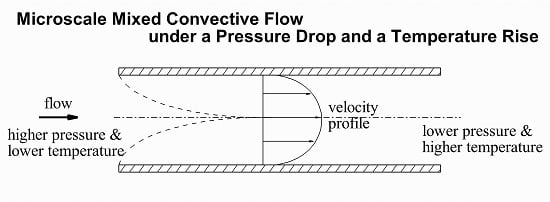Combined Forced and Thermocreep Convection through a Long Horizontal Microchannel
Abstract
:1. Introduction
2. Basic Equations
2.1. Field Equations and Slip Conditions
2.2. Non-Dimensionalization
3. Analytical Solutions
4. Results and Discussion
5. Conclusions
Acknowledgments
Author Contributions
Conflicts of Interest
Abbreviations
| cp | specific heat at constant pressure (J/kg·K) |
| Ec | Ecker number |
| g | gravitational acceleration (m/s2) |
| Gr | Grashof number |
| K | thermal conductivity (W/m·K) |
| Kn | Knudsen number |
| l | channel length (m) |
| L | dimensionless channel length |
| dimensionless volume flow rate | |
| dimensionless average heat transfer rate | |
| p | pressure (Pa) |
| P | dimensionless pressure |
| dimensionless pressure drop | |
| Pr | Prandtl number |
| heat absorbed by fluid between channel entry and channel exit (W/m) | |
| qi | heat flux vector expressed in index notation (W/m) |
| specific gas constant (m2/K·s2) | |
| T | temperature (K) |
| μx, μy | velocity components in x, y directions (m/s) |
| U | dimensionless velocity |
| Us | dimensionless velocity slip |
| w | channel width (m) |
| x,y | rectangular coordinate system (m) |
| X,Y | dimensionless rectangular coordinate system |
| β | thermal expansion coefficient (1/K) |
| γ | specific heat ratio |
| dimensionless average flow drag | |
| λ | molecular mean free path (m) |
| dimensionless temperature | |
| μ | shear viscosity (kg/m·s) |
| ρ | density (kg/m3) |
| Σe | thermal accommodation coefficient |
| σv | tangential momentum accommodation coefficient |
| τij | stress tensor expressed in index notation (Pa) |
| τw | flow drag on wall surface per unit area (Pa) |
| c | characteristic values |
| gw | gas values near the wall surface |
| i | inlet values |
| r, t | gas values near the wall surface in the normal and tangential directions, respectively |
| w | wall values |
| 0, 1 | reservoir and discharge-area values, respectively |
References
- Weng, H.C.; Chen, C.K.; Chang, M.H. Magnetoviscosity in magnetic fluids: Testing different models of the magnetization equation. Smart Sci. 2013, 1, 51–58. [Google Scholar]
- Malvandi, A.; Ganji, D.D. Mixed convective heat transfer of water/alumina nanofluid inside a vertical microchannel. Powder Technol. 2014, 263, 37–44. [Google Scholar] [CrossRef]
- Salman, B.H.; Mohammed, H.A.; Kherbeet, A.S. Numerical and experimental investigation of heat transfer enhancement in a microtube using nanofluids. Int. Commun. Heat Mass Transfer 2014, 59, 88–100. [Google Scholar] [CrossRef]
- Lo, K.J.; Weng, H.C. Convective heat transfer of magnetic nanofluids in a microtube. Smart Sci. 2015, 3, 56–64. [Google Scholar]
- Zhao, Q.; Yue, X.; Wang, F. Gas flow property in microtube and its effect on gaseous seepage. Pet. Sci. Technol. 2014, 32, 1569–1577. [Google Scholar] [CrossRef]
- Larina, I.N.; Rykov, V.A. Numerical study of unsteady rarefied diatomic gas flows in a plane microchannel. Comput. Math. Math. Phys. 2014, 54, 1293–1304. [Google Scholar] [CrossRef]
- Sebastiao, I.B.; Santos, W.F.N. Gas-surface interaction impact on heat transfer and pressure distributions of a high speed microchannel flow. Appl. Therm. Eng. 2014, 62, 58–68. [Google Scholar] [CrossRef]
- Liou, T.M.; Lin, C.T. Three-dimensional rarefied gas flows in constricted microchannels with different aspect ratios: asymmetry bifurcations and secondary flows. Microfluid. Nanofluid. 2015, 18, 279–292. [Google Scholar] [CrossRef]
- Wu, P.; Little, W.A. Measurement of the heat transfer characteristics of gas flow in fine channel heat exchangers used for microminiature refrigerators. Cryogenics 1984, 24, 415–420. [Google Scholar] [CrossRef]
- Kobayashi, J.; Mori, Y.; Okamoto, K.; Akiyama, R.; Ueno, M.; Kitamori, T.; Kobayashi, S. A microfluidic device for conducting gas-liquid-solid hydrogenation reactions. Science 2004, 304, 1305–1308. [Google Scholar] [CrossRef] [PubMed]
- Yeom, J.; Mozsgai, G.Z.; Flachsbart, B.R.; Choban, E.R.; Asthana, A.; Shannon, M.A.; Kenis, P.J.A. Microfabrication and characterization of a silicon-based millimeter scale, PEM fuel cell operating with hydrogen, methanol, or formic acid. Sens. Actuators B 2005, 107, 882–891. [Google Scholar] [CrossRef]
- Erbas, N.; Baysal, O. Micron-level actuators for thermal management of microelectronic devices. Heat Transfer Eng. 2009, 30, 138–147. [Google Scholar] [CrossRef]
- Schaaf, S.A.; Chambré, P.L. Flow of Rarefied Gases; Princeton University Press: Princeton, NJ, USA, 1961. [Google Scholar]
- Arkilic, E.B.; Schmidt, M.A.; Breuer, K.S. Gaseous slip flow in long microchannels. J. Microelectromech. Syst. 1997, 6, 167–178. [Google Scholar] [CrossRef]
- Beskok, A.; Karniadakis, G.E. A model for flows in channels, pipes, and ducts at micro and nano scales. Microscale Thermophys. Eng. 1999, 3, 43–77. [Google Scholar]
- Ewart, T.; Perrier, P.; Graur, I.; Méolans, J.G. Mass flow rate measurements in a microchannel, from hydrodynamic to near free molecular regimes. J. Fluid Mech. 2007, 584, 337–356. [Google Scholar] [CrossRef]
- Weng, H.C.; Chen, C.K. A challenge in Navier–Stokes-based continuum modeling: Maxwell–Burnett slip law. Phys. Fluids 2008, 20, 106101. [Google Scholar] [CrossRef]
- Perrier, P.; Graur, I.A.; Ewart, T.; Meolans, J.G. Mass flow rate measurements in microtubes: From hydrodynamic to near free molecular regime. Phys. Fluids 2011, 23, 042004. [Google Scholar] [CrossRef]
- Chen, C.K.; Weng, H.C. Natural convection in a vertical microchannel. J. Heat Transf. 2005, 127, 1053–1056. [Google Scholar] [CrossRef]
- Weng, H.C.; Chen, C.K. Fully developed thermocreep-driven gas microflow. Appl. Phys. Lett. 2008, 92, 094105. [Google Scholar] [CrossRef]
- Tunc, G.; Bayazitoglu, Y. Heat transfer in rectangular microchannels. Int. J. Heat Mass Transfer 2002, 45, 765–773. [Google Scholar] [CrossRef]
- Renksizbulut, M.; Niazmand, H.; Tercan, G. Slip-flow and heat transfer in rectangular microchannels with constant wall temperature. Int. J. Therm. Sci. 2006, 45, 870–881. [Google Scholar] [CrossRef]
- Aydin, O.; Avci, M. Heat and fluid flow characteristics of gases in micropipes. Int. J. Heat Mass Transfer 2006, 49, 1723–1730. [Google Scholar] [CrossRef]
- Avci, M.; Aydin, O. Laminar forced convection slip-flow in a micro-annulus between two concentric cylinders. Int. J. Heat Mass Transfer 2008, 51, 3460–3467. [Google Scholar] [CrossRef]
- Shojaeian, M.; Dibaji, S.A.R. Three-dimensional numerical simulation of the slip flow through triangular microchannels. Int. Commun. Heat Mass Transfer 2010, 37, 324–329. [Google Scholar] [CrossRef]
- Sadeghi, A.; Saidi, M.H. Viscous dissipation and rarefaction effects on laminar forced convection in microchannels. J. Heat Transf. 2010, 132, 072401. [Google Scholar] [CrossRef]
- Çetin, B. Effect of thermal creep on heat transfer for a two-dimensional microchannel flow: An analytical approach. J. Heat Transf. 2013, 135, 101007. [Google Scholar] [CrossRef]
- Weng, H.C.; Chen, D.C. Magnetogasdynamic flow and heat transfer in a microchannel with isothermally heated walls. Int. J. Heat Mass Transfer 2013, 57, 16–21. [Google Scholar] [CrossRef]
- Buonomo, B.; Manca, O.; Lauriat, G. Forced convection in micro-channels filled with porous media in local thermal non-equilibrium conditions. Int. J. Therm. Sci. 2014, 77, 206–222. [Google Scholar] [CrossRef]
- Weng, H.C. Second-order slip flow and heat transfer in a long isoflux microchannel. Int. J. Mech. Aerosp. Ind. Mechatronics Manuf. Eng. 2014, 8, 1452–1455. [Google Scholar]
- Weng, H.C.; Liu, C.H. Second-order slip flow and heat transfer in a long isothermal microchannel. Int. J. Mech. Aerosp. Ind. Mechatronics Manuf. Eng. 2015, 9, 1302–1305. [Google Scholar]
- Wang, K.Y.; Tavakkoli, F.; Wang, S.J.; Vafai, K. Forced convection gaseous slip flow in a porous circular microtube: An exact solution. Int. J. Therm. Sci. 2015, 97, 152–162. [Google Scholar] [CrossRef]
- Chen, C.K.; Weng, H.C. Developing natural convection with thermal creep in a vertical microchannel. J. Phys. D 2006, 39, 3107–3118. [Google Scholar] [CrossRef]
- Haddad, O.M.; Abuzaid, M.M.; Al-Nimr, M.A. Developing free-convection gas flow in a vertical open-ended microchannel filled with porous media. Numer. Heat Transfer Part A 2005, 48, 693–710. [Google Scholar] [CrossRef]
- Biswal, L.; Som, S.K.; Chakraborty, S. Effects of entrance region transport processes on free convection slip flow in vertical microchannels with isothermally heated walls. Int. J. Heat Mass Transfer 2007, 50, 1248–1254. [Google Scholar] [CrossRef]
- Chakraborty, S.; Som, S.K.; Rahul. A boundary layer analysis for entrance region heat transfer in vertical microchannels within the slip flow regime. Int. J. Heat Mass Transfer 2008, 51, 3245–3250. [Google Scholar] [CrossRef]
- Weng, H.C.; Chen, C.K. Variable physical properties in natural convective gas microflow. J. Heat Transf. 2008, 130, 082401. [Google Scholar] [CrossRef]
- Weng, H.C.; Chen, C.K. On the importance of thermal creep in natural convective gas microflow with wall heat fluxes. J. Phys. D 2008, 41, 115501. [Google Scholar] [CrossRef]
- Weng, H.C.; Chen, C.K. Drag reduction and heat transfer enhancement over a heated wall of a vertical annular microchannel. Int. J. Heat Mass Transfer 2009, 52, 1075–1079. [Google Scholar] [CrossRef]
- Buonomo, B.; Manca, O. Natural convection slip flow in a vertical microchannel heated at uniform heat flux. Int. J. Therm. Sci. 2010, 49, 1333–1344. [Google Scholar] [CrossRef]
- Buonomo, B.; Manca, O. Transient natural convection in a vertical microchannel heated at uniform heat flux. Int. J. Therm. Sci. 2012, 56, 35–47. [Google Scholar] [CrossRef]
- Wang, C.Y.; Ng, C.O. Natural convection in a vertical slit microchannel with superhydrophobic slip and temperature jump. J. Heat Transf. 2014, 136, 034502. [Google Scholar] [CrossRef]
- Jha, B.K.; Aina, B.; Muhammad, S.A. Combined effects of suction/injection and wall surface curvature on natural convection flow in a vertical micro-porous annulus. Thermophys. Aeromechanics 2015, 22, 217–228. [Google Scholar] [CrossRef]
- Avci, M.; Aydin, O. Mixed convection in a vertical parallel plate microchannel. J. Heat Transf. 2007, 129, 162–166. [Google Scholar] [CrossRef]
- Avci, M.; Aydin, O. Mixed convection in a vertical parallel plate microchannel with asymmetric wall heat fluxes. J. Heat Transf. 2007, 129, 1091–1095. [Google Scholar] [CrossRef]
- Avci, M.; Aydin, O. Mixed convection in a vertical microannulus between two concentric microtubes. J. Heat Transf. 2009, 131, 014502. [Google Scholar] [CrossRef]
- Weng, H.C.; Jian, S.J. Developing mixed convection in a vertical microchannel. Adv. Sci. Lett. 2012, 9, 908–913. [Google Scholar] [CrossRef]
- Jian, S.J.; Weng, H.C. Second-order mixed convective flow in a long vertical microchannel. J. Heat Transf. 2013, 135, 022506. [Google Scholar] [CrossRef]
- Sadeghi, A.; Baghani, M.; Saidi, M.H. Gaseous slip flow mixed convection in vertical microducts with constant axial energy input. J. Heat Transf. 2014, 136, 032501. [Google Scholar] [CrossRef]
- Akbulut, U. Entropy generation of mixed convection in a vertical parallel plate microchannel with asymmetric wall heat flux. Int. J. Exergy 2015, 18, 462–479. [Google Scholar] [CrossRef]
- Guo, Z.Y.; Wu, X.B. Compressibility effect on the gas flow and heat transfer in a microtube. Int. J. Heat Mass Transfer 1997, 40, 3251–3254. [Google Scholar] [CrossRef]
- Munson, B.R.; Okiishi, T.H.; Huebsch, W.W.; Rothmayer, A.P. Fluid Mechanics, 7th ed.; John Wiley & Sons: New York, NY, USA, 2013. [Google Scholar]
- Maxwell, J.C. On stress in rarefied gases from inequalities of temperature. Philos. Trans. R. Soc. London 1879, 170, 231–256. [Google Scholar] [CrossRef]
- Kennard, E.H. Kinetic Theory of Gasses; McGraw-Hill: New York, NY, USA, 1938. [Google Scholar]
- Bown, M.R.; MacInnes, J.M.; Allen, R.W.K.; Zimmerman, W.B.J. Three-dimensional, three-component velocity measurements using stereoscopic micro-PIV and PTV. Meas. Sci. Technol. 2006, 17, 2175–2185. [Google Scholar] [CrossRef]
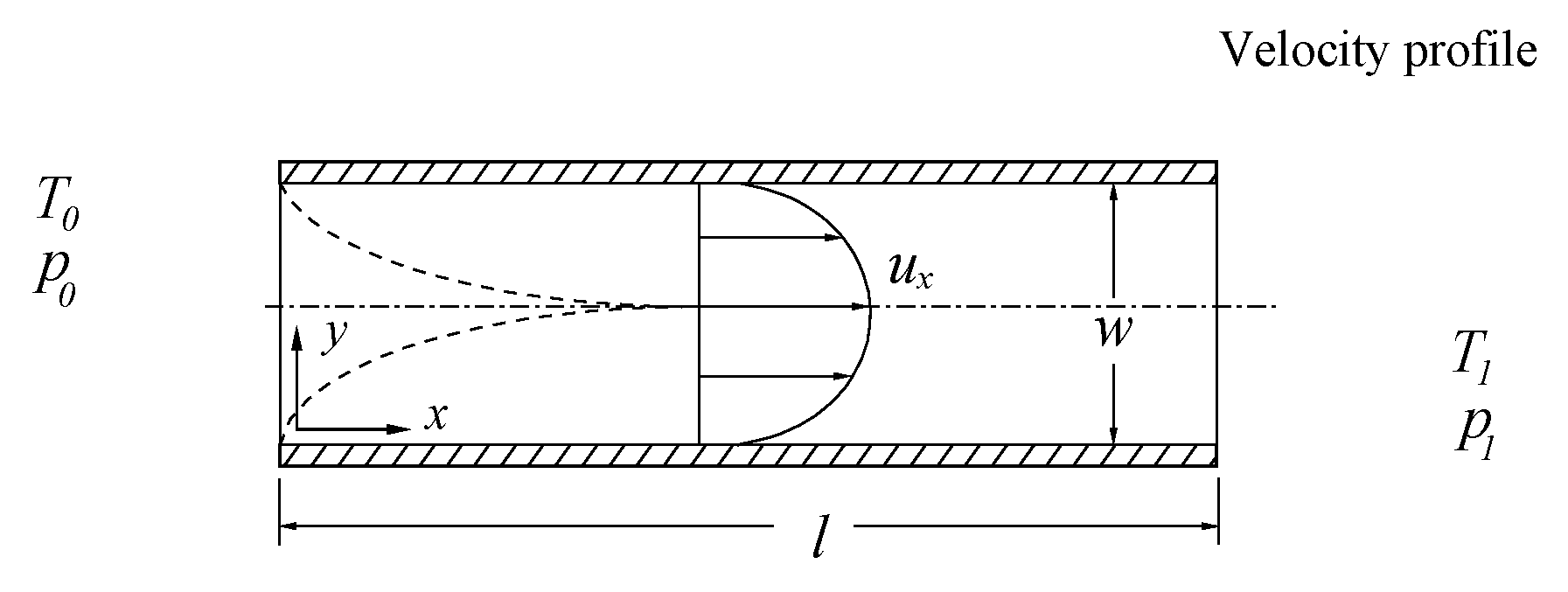
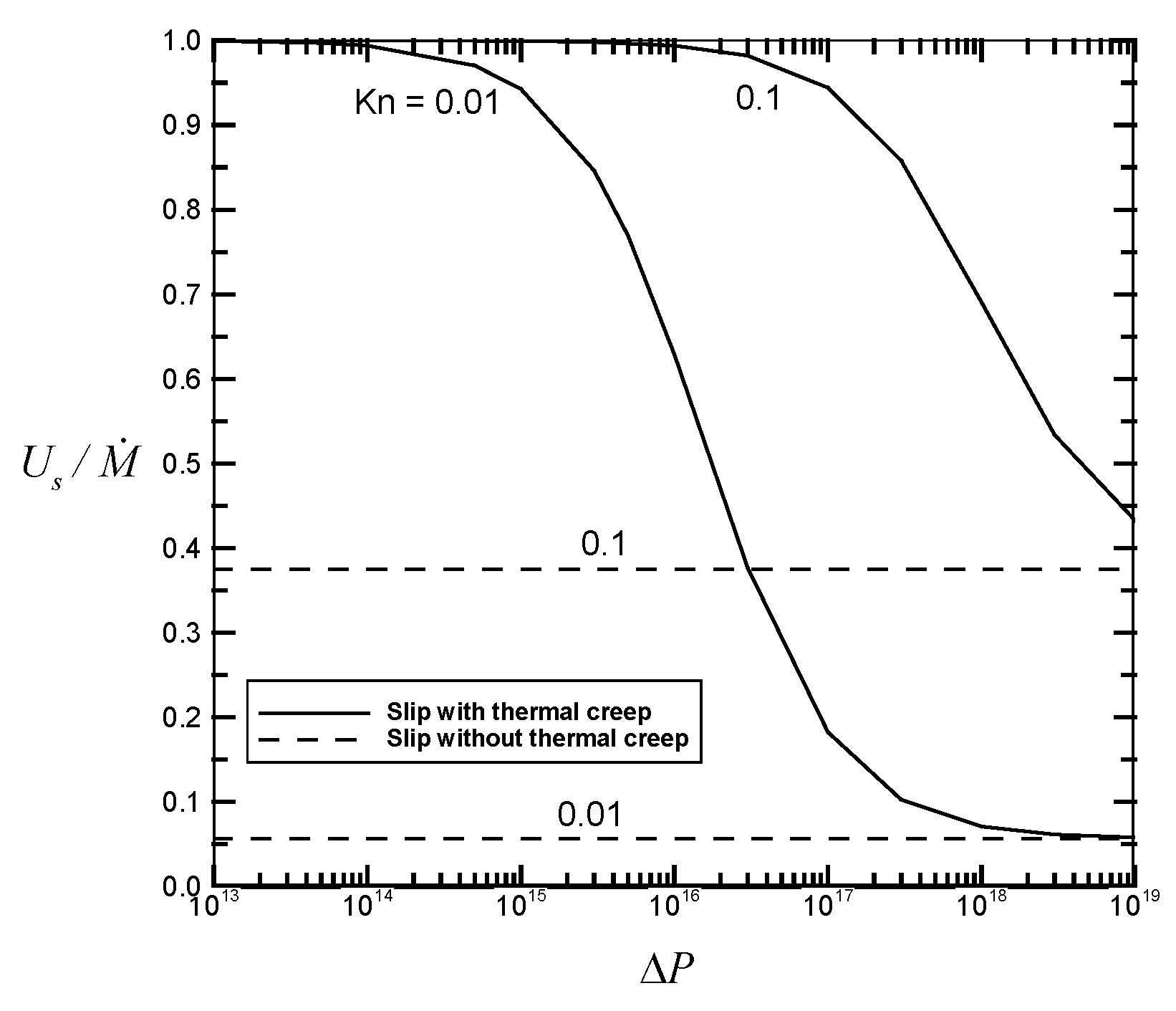

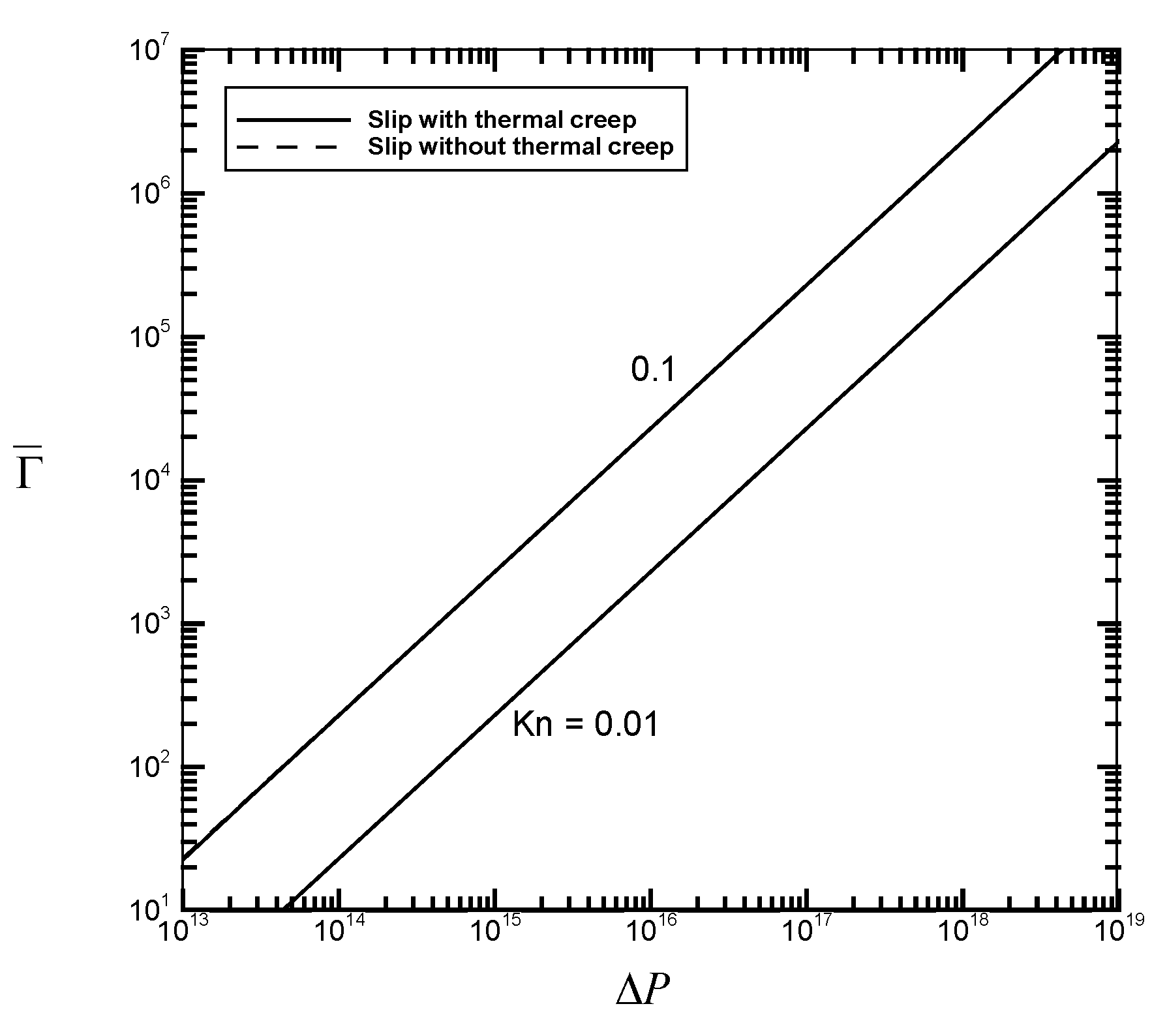
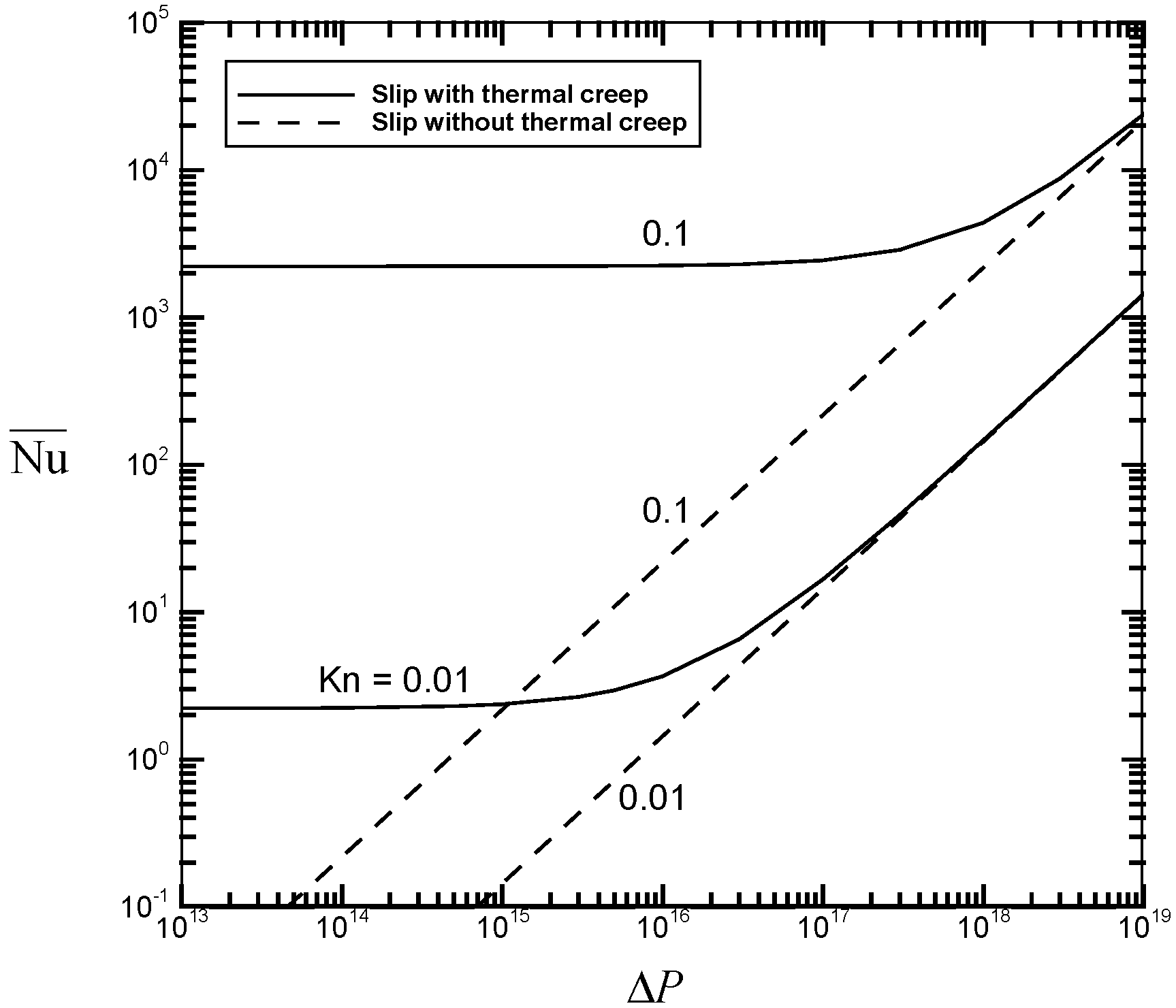
© 2016 by the author. Licensee MDPI, Basel, Switzerland. This article is an open access article distributed under the terms and conditions of the Creative Commons by Attribution (CC-BY) license ( http://creativecommons.org/licenses/by/4.0/).
Share and Cite
Weng, H.C. Combined Forced and Thermocreep Convection through a Long Horizontal Microchannel. Micromachines 2016, 7, 33. https://doi.org/10.3390/mi7020033
Weng HC. Combined Forced and Thermocreep Convection through a Long Horizontal Microchannel. Micromachines. 2016; 7(2):33. https://doi.org/10.3390/mi7020033
Chicago/Turabian StyleWeng, Huei Chu. 2016. "Combined Forced and Thermocreep Convection through a Long Horizontal Microchannel" Micromachines 7, no. 2: 33. https://doi.org/10.3390/mi7020033





